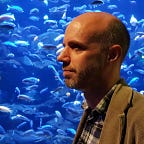‘Bande a part’ or — Paris Belongs To Them ?
‘A hoard of money… an English class… a house by the river… a starry-eyed girl.’ Godard gives us all the ingredients for ‘Bande a part’ (1964) at the very beginning of the picture, especially for those who have come in late, but in a way we’ve all come in late as watching ‘Bande a part’ is like jumping onto an already moving train because this is a movie in constant motion. If we’re lucky we can just catch it.
A young woman meets two “boys” at English class. She has a rich aunt who has a big pile of cash so the two boys decide to steal it. And that’s about it although the obvious question is if that’s about it then what is it about? Style? Film? Youth? For me it’s about Godard coming back from Italy and having uncomtemptuous fun in Paris again; maybe he temporarily left a little bit of bitterness back in Capri along with his swimming trunks and suntan lotion? A mischievous sense of humour has always been writ large in Godard but with ‘Bande a part’ you get the sense of him actually having fun and if you watch this movie then you’ll have fun too.
I’d never seen the film before but knew about it and its influence, and the influence of ‘Band a part’ is crystal clear and yet although countless filmmakers have ripped-off, homaged or outright stolen the choreography of the famous Madison dance scene I couldn’t help thinking why has no one done so with the sound design? During the sequence Godard once again hard cuts from music to narration to location recording creating an effect that gives our attention a serious and vigorous work out. It’s exciting and captivating. Yet so many of its imitators treat this scene purely as a music video or a dance sequence and so use a continuous, uninterrupted soundtrack meaning we not only get half the “picture” but miss the entire point.
For example — can you really imagine Quentin Tarantino, who loves this movie, desecrating “his” soundtracks by sonically slicing them up so brutally, so radically? That would be the one act of violence Tarantino would find beyond the pale; he would view it as a form of self-harm. He’ll happily cut off someone’s ear for a shock but take a knife to the music? It would make him blanche and turn away in disgust. Likewise in the visual department with Bertolucci who happily stole, amongst so much else from here, the Louvre dash… but would, or could, Bertolucci allow a single frame of a self-sabotaging, self-deprecating joke into any of his work the way Godard does with abandon? Again, he’d see it as a form of desecration. Bertolucci is no fun.
Yet there is so much to greedily steal from here, so many enticing moments, but the film is also very much about how those moments are held and strung together and Godard seems to do this with the camera pan plus the movement of backgrounds. In many of the shots the camera will swivel from left to right (or vice versa) but there is always a train or a car travelling in the opposite direction to act as a counter-force. Again, as with his use of sound, the effect energises us. Notice the scene between Anna Karina and Claude Brasseur on the train around the film’s midpoint and how the background “moves”… and also doesn’t. The train departs and the static background glides from right to left as we watch the two lovers talk. Then there is blackness but we are still in motion. Cut to a man reading his paper then back to boy and girl and the sense of continued movement and motion, except this time the train is in a state of rest and it is the background itself that is in locomotion before we once again start moving and the illusion is again replaced. A joke has been played on us, the only question is ‘Did we notice?’.
This is one of the reasons the Louvre dash works so well, not just because it’s young people running through an art gallery with glee. It only consists of three shots but look at the way we are visually, and sonically, brought into and out of the moment — it’s by the flow of the Seine, the camera panning from left to right along the river as our three leads suddenly run right to left before being taken up again by the river’s unchanging current, and an echoing laugh of delight, out of the building and back on our course. It doesn’t work in isolation (try watching that sequence on fast forward and the effect is more apparent).
This flow happens almost constantly throughout the movie with my favourite moment being, unsurprisingly, a typical Godardian in-joke on the whole process. It’s the shot 1:08:40 in when the trio are driving along and camera follows them… only to be distracted in mid-pan by the lovely sight of a beautifully composed image of a barge slowly making its way along an adjacent river, before the camera realises that it’s meant to be following the actors and frantically, yet precisely, snaps back to the action to do its professional job. The entire shot lasts only a few seconds yet seems to contain so much,especially humour.
The movie is only 95 minutes long and consists of nothing but moments like this. ‘Bande a part’ might be made using only four ingredients but look at how much you can do with just that.
